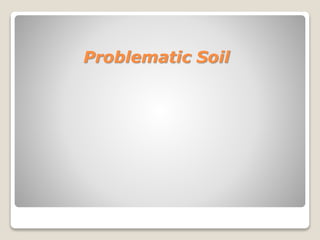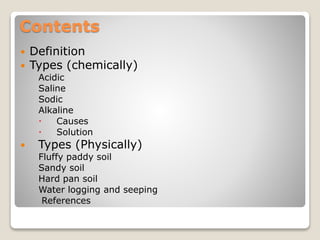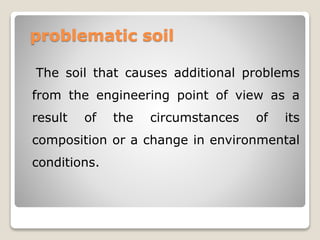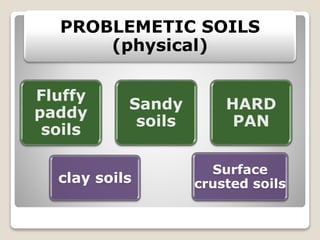Problematic soil
- 2. Contents ï Definition ï Types (chemically) Acidic Saline Sodic Alkaline ï Causes ï Solution ï Types (Physically) Fluffy paddy soil Sandy soil Hard pan soil Water logging and seeping References
- 3. problematic soil The soil that causes additional problems from the engineering point of view as a result of the circumstances of its composition or a change in environmental conditions.
- 4. Acidic Saline Sodic soil Alkaline Problematic soils (Chemical)
- 5. ï The soil having PH less than 7 is called acidic soil ï Extremely acidic soil has PH between 4-4.75 Causes of Acidic Soil? There are three basic things (PNK) that cause acidic soil. The first, and most common, is simply that the organic matter and minerals that break down in a soil over time are acidic in nature, and make the soil acidic. This is common in pine forests and peat bogs. ï Acid rain also becomes a cause of acid soil
- 6. Acid Soil Solution Adding pulverized limestone or dolomite limestone (which has magnesium in addition to the calcium carbonate that makes up regular lime) is one of the fastest ways to increase your soil's pH. You'll generally want to look for something called "garden lime" or the above-mentioned "dolomite limestone" for your garden.
- 8. The soil with excess salt (NaCl) is called saline soil Salt Sources These salts originate from the natural weathering of minerals or from fossil salt deposits left from ancient sea beds. Saline soil problems It is caused by the accumulation of soluble salts in the root zone. These excess salts reduce plant growth by altering water uptake and causing imbalances
- 10. Saline Soil Solution There are two ways to manage saline soils: ïķ First, salts can be moved below the root zone by applying more water than the plant needs. This method is called the leaching requirement method. ïķ Second, salts can be moved away from the root zone to locations in the soil, other than below the root zone, where they are not harmful.
- 11. Sodic soil Soils with high levels of exchangeable sodium (Na) and low levels of total salts are called Sodic soils Causes: Sodic soils may impact plant growth by: 1.) Specific toxicity to sodium sensitive plants 2.) Nutrient deficiencies or imbalances 3.) High pH
- 12. Sodic Soil Solution ï There are usually three options for correcting soil-related problems: ïķchange the plant species to a more tolerant species ïķchange the variety to a more tolerant variety ïķchange the soil.
- 13. Sodic Soil
- 14. Alkalisoil Alkali, or alkaline, soils are clay soils with high pH, a poor soil structure and a low infiltration capacity. Often they have a hard calcareous layer at 0.5 to 1 meter depth. Causes: ïķThe causes of soil alkalinity are natural or they can be man-made ïķ natural cause is the presence of soil minerals producing sodium carbonate (Na2CO3) and sodium bicarbonate (NaHCO3) upon weathering ïķ no other source of man made sodium salts addition to the agriculture fields
- 15. Alkali soil Solution: Alkaline soils with solid CaCO3 can be reclaimed with grass cultures, organic compost, waste hair and feathers, organic garbage, etc. ensuring the incorporation of much acidifying material (inorganic or organic material) into the soil, and enhancing dissolved Ca in the field water by releasing CO2 gas. Deep plowing and incorporating the calcareous subsoil into the top soil also helps
- 16. PROBLEMETIC SOILS (physical) Fluffy paddy soils Sandy soils HARD PAN Surface crusted soilsclay soils
- 17. ï They are characterised by low bulk density of the topsoil resulting in the sinking of farm animals and labourers as well as poor anchorage to paddy seedlings. ï Such soils can be reclaimed by, passing of 400 kg stone roller.
- 20. The size of the particles are the largest. It is granular and consists of rock and mineral particles that are very small. The texture is coarse.. Sandy soil is composed of 60-70% sand, 20-25% silt and 10-15% clay.
- 21. ï Hard pan occurs in red soil areas below 15 cm depth due to the movement of clay and iron hydroxides and settling at shallow depth, preventing the root proliferation. These soils can be reclaimed by ï Chiselling the soils with chisel plough at 0.5 m interval first in one direction and then in the direction perpendicular to the previous one, once in three years.
- 22. Hard Pan Soil
- 23. ï The soils are weakly aggregated soil structure are easily broken by the impact of rain drops resulting in the formation of clay crust at the soil surface. ï The clay pan prevent the emerging seedlings and arrest the free exchange of gasses between the soil and atmosphere
- 25. soft clay soil ï soft clay soil Defined as saturated clay soils that have low values of shear strength and coefficient of textures also have high values for compression and secondary compression and creep behavior.
- 26. collapsible soil A soil which is possible to bear high stress value low settlement. In case that soil exposed to high amount of moisture they quickly collapse and a high settlement occur.
- 27. Swelling soil ï Swelling soil Is the soil that gives a significant increase in size when absorbed water as it gives high shrinkage ratio at the exit of the water. The swelling ratio depends on increasing dry density and increase the percentage of clay
- 28. DISPERSIVE SOILS ï Dispersion can occur in any given soil with a high percentage of exchangeable sodium percentage (ESP), causing internal erosion and eventually piping through embankment dams.
- 30. Water logging refers to the saturation of soil with water. Soil may be regarded as water logged when the water table of the groundwater is too high to conveniently permit an anticipated activity, like agriculture. Water Logging
- 31. Causes Of Water Logging (3)-Impervious Obstruction. (4)-Inadequate Drainage. (5)-Impervious Soil (6)-Flat country Slope
- 32. Water Logging
- 33. Prevention Of Water Logging There are many following steps to control the water logging: Canal Closures Lowering Full Supply Level Lining Of Canals and water courses Provision Of Intercepting Drains Provision Of Surface Drains Pumping Plantation Crop Rotation
- 34. Seepage of water
- 35. Pumping




































